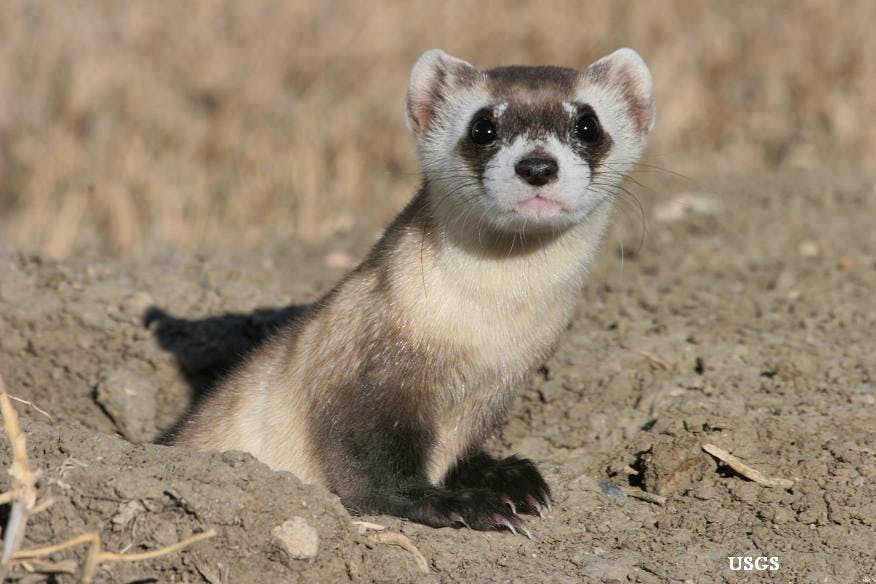“Coast to Coast” is a summer blog series highlighting some of America’s most imperiled wildlife. By using the U.S. Fish and Wildlife Service’s new state-by-state endangered species map, we will tell stories about native plants and animals in unique landscapes where Defenders will be focusing its conservation efforts in coming years.
One of the world’s most endangered animals is also arguably one of the world’s most adorable. With limbs dipped in black and a mask like a bandit, the black-footed ferret looks like a stretched-out panda bear. But don’t be deceived by its cuddly appearance. This critter is a voracious nocturnal carnivore that preys almost exclusively on prairie dogs.
The ferret’s habitat once extended across the Great Plains from Canada to Mexico. Unfortunately disease, habitat destruction and elimination of their primary food source have taken a toll on this small predator. Today, less than five percent of the ferret’s original prairie dog colony habitat remains. As people moved westward, the prairie disappeared, and so did the ferret’s food source. Prairie dogs became the target of widespread eradication efforts. Considered vermin because they clipped the grass short on their colonies, ranchers went to great lengths to rid their newly acquired land of prairie dogs. Some states, such as Kansas, passed laws that required the killing of all prairie dogs. Piles of poisoned prairie dogs can be seen in photos from the turn of the last century. With no food and nowhere to go, the black-footed ferret was on the brink of extinction. The species became so rare that by 1974 no known ferrets remained in the wild. When the last captive black-footed ferret died in 1979, the species was presumed to be extinct.
Then in 1981 one lucky dog stumbled upon a ferret in Wyoming. Watch the following video to find out about the incredible find back in 1981.
Researchers discovered that a few dozen ferrets lived in the area and continued to monitor the population for a few years. Then tragedy struck; disease proved deadly to prairie dog and ferret populations, and brought the black-footed ferret once again to the brink of extinction. Their numbers dwindled to a scarily low 18 individuals in 1986.
Those last 18 ferrets found were brought into a captive breeding program. Over time, biologists became very successful at breeding ferrets; over 7,000 kits have been born in captivity. Once numbers reached a sustainable level, ferret reintroduction began. . Now, nearly two decades later, the ferret is on the road to recovery. Last year marked the 30th year anniversary of their rediscovery and the 20th year of their reintroduction to the wild. They have been reintroduced to 19 sites from Canada to Mexico. Of these, four sites are considered a success, two have failed, and the other 13 are yet to be determined.
Listen to the U.S. Fish and Wildlife Service describe the important recovery efforts under way in the following podcast:*
Audio clip: Adobe Flash Player (version 9 or above) is required to play this audio clip. Download the latest version here. You also need to have JavaScript enabled in your browser.
Defenders of Wildlife supports this small predator’s success as an official member of the U.S. Fish and Wildlife Service’s Black-Footed Ferret Recovery Implementation Team. Over three dozen governmental agencies and non-profit organizations pool their resources and expertise. While partnering with federal agencies, Defenders also partners with tribal and private landowners to secure crucial habitat for the prairie dog and the black-footed ferret. We have helped with ferret recovery efforts at Northern Cheyenne Reservation, Lower Brule Reservation, Cheyenne River Reservation, Rosebud Reservation, and with private landowners in Kansas, among other sites.
It takes a team to save valuable species. Without coalitions like this, rare species don’t stand chance.
Click here to learn more about what Defenders is doing to help black-footed ferrets.
To find out how you can help, visit the Black-footed Ferret Recovery Program at www.blackfootedferret.org
*The podcast featured in this blog post was edited to comply with file size restrictions. The content of the podcast has not been changed.






Follow Defenders of Wildlife
facebook twitter instagram youtube tiktok threads